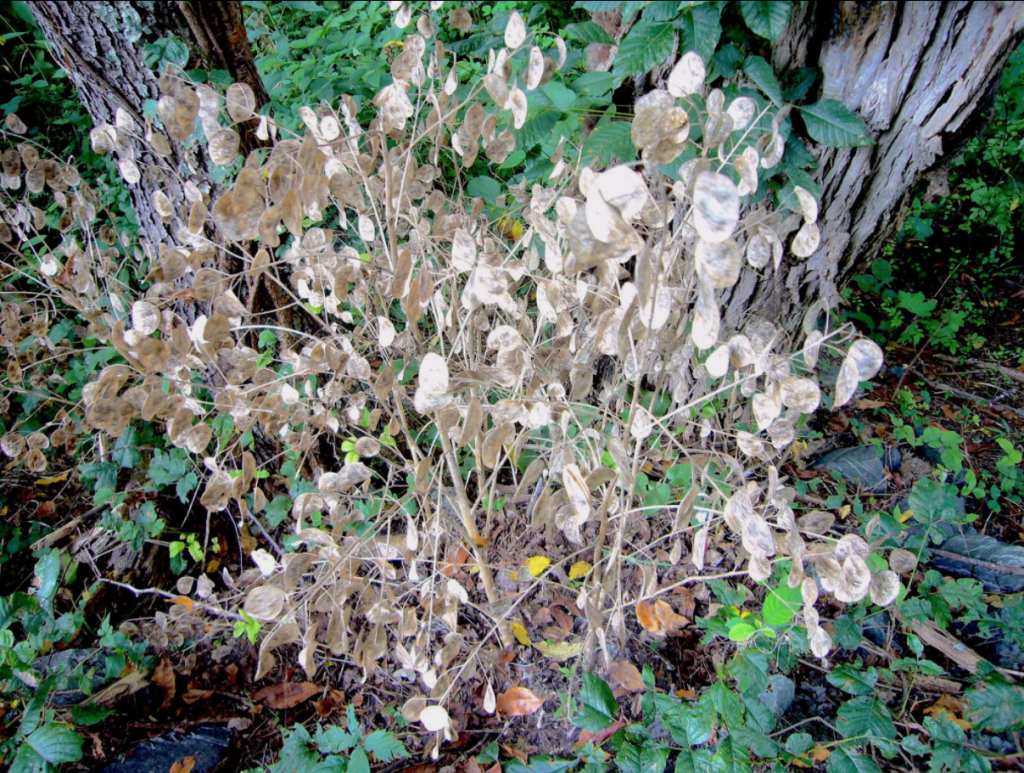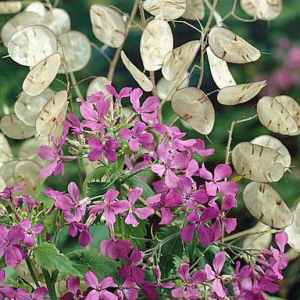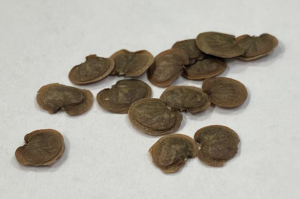
Self-seeded Moon Plant in North Carolina forest. Photo by Green Deane
It looks like a fake plant created for a low-budget space movie. It even has a good name: Lunaria annua, Annual Moon. It’s also edible. I first saw them was in mile-high Beech Mountain, a city near Boone North Carolina. Then later I saw them growing on my cousin’s property in upstate South Carolina.

The blossom tell you it’s in the mustard family.
Lunaria annua (loo-NAIR-ee-uh AN-yoo-uh) is a purple-flowered native of southeastern Europe* — the Balkans — and western Asia. Its unconventional seed pods (silicles SILL-ah-cle) prompted the species to be used as a garden ornamental. It’s been widely planted in the United States and Canada. It’s also widely scattered in Great Britian — introduce there 400 years ago, it was popular in the Victorian era. The species is listed as invasive in Australia (and the U.S.) As you might also presume it is a popular in flower arranging. A relative, Lunaria annua var. alba, has white flowers, L. alba var. albiflora ‘Alba Variegata, is variegated with white trimming on its leaves. There is also a Lunaria rediviva which has oval seed pods and likes to be slightly damp. There are about a dozen plants in the genus. Lunaria is sometimes confused with Dame’s Rocket, Hesperis matronalis, which is also edible (young leaves, seedpods, flowers and seeds sprouted.)

Lunaria annua seeds.
Other common names for Lunaria annua include Honesty, Silver Dollar, Dollar Plant, Money Plant, Moneywort, Moonwort, Satin Flower, and Kuuruoho (yes, that is spelled correctly.) It was also once known as Lunaria biennis. The plant attracts butterflies, long-tongued bees and is disease/pest resistant.
It was one of the first European flowers introduce into the American colonies where it was value for its striking seedpods and edible roots. Thomas Jefferson was growing them in 1767.
Green Deane’s Itemized Plant Profile
Identification: Two to three feet tall with alternate to opposite, oval to heart-shaped leaves. They are toothy, medium green and slightly fuzzy, pointed at the tip, upper leaves are stemless. Four-petaled purple flowers are in racemes above the leaves in spring. Flowers are replaced with flattened, paper-thin, silver-dollar sized fruit which become translucent. Several seeds are in the fruit and are easy to winnow.
Time of year. As the plant has a long juvenile stage it should be planted in very early spring for a late summer or fall harvest. They can take a frost and temperatures down to 10.6 F. Biannual, it produces only leaves the first year and is a small plant that year; as a tall plant flowers and seeds the second year. As it reseeds you only have to plant it once. Soak the seeds in water a day hours before planting.
Environment: Edges and transition zones. Open woodlands, naturalized areas such as permaculture lots with native and non-native species, semi-shady gardens. It likes well-drained, rich soil, full sun in cooler climates, afternoon shade in warmer areas. It needs six hours of sunlight a day, an is hardy in zones 5a, 5b, 6b, 6a, 7a, 7b, 8a, 8b, 9b, and. 9a
Method of Preparation: The thick root is edible raw or cooked before blossoming. When the energy in the root is used to make flowers and seed the roots usually get tough. Cooked, pungent seeds are a mustard substitute. The seed is 30 to 38% oil, high in erucic acid, 44%, and nervonic acid, 23% (which is a base material in creating medicine for multiple sclerosis.) The long-chain oil itself is also a high-temperature lubricant. As with most mustards most of the plant is edible — leaves, flowers and unripe fruit — but are bitter. It is also believed to be high in vitamin C as most mustards are. Leaves are edible by rabbits.
*To be more specific it is native to Albania, Bulgaria, France, Greece, Italy, Crete, Romania, Spain, Switzerland, and Yugoslavia. It has been introduce into: Alabama, southern Argentina, Austria, the Baltic States, Belarus, Belgium, British Columbia, California, Colorado, Connecticut, Czechoslovakia, Delaware, Denmark, Germany, Great Britain, Hungary, Idaho, Illinois, India, Indiana, Ireland, Kentucky, Madeira, Maine, Manitoba, Maryland, Massachusetts, Michigan, New Hampshire, New York, Norway, Nova Scotia, Ohio, Ontario, Oregon, Pakistan, Pennsylvania, Québec, Rhode I., Sweden, Tennessee, Ukraine, Utah, Vermont and Washington

